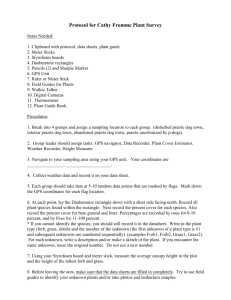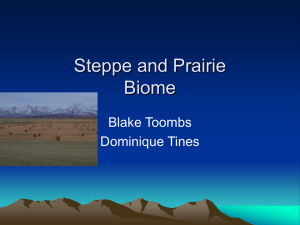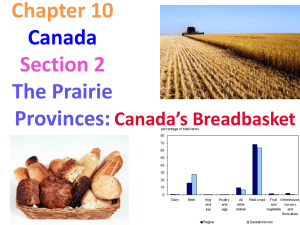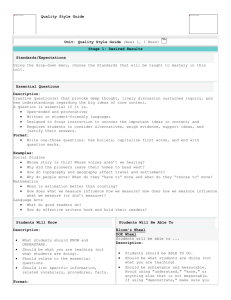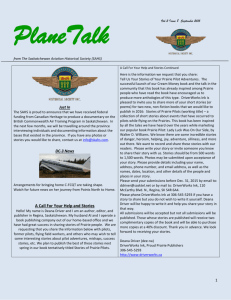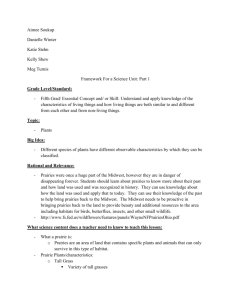the prairie point - Purdue Agriculture
advertisement
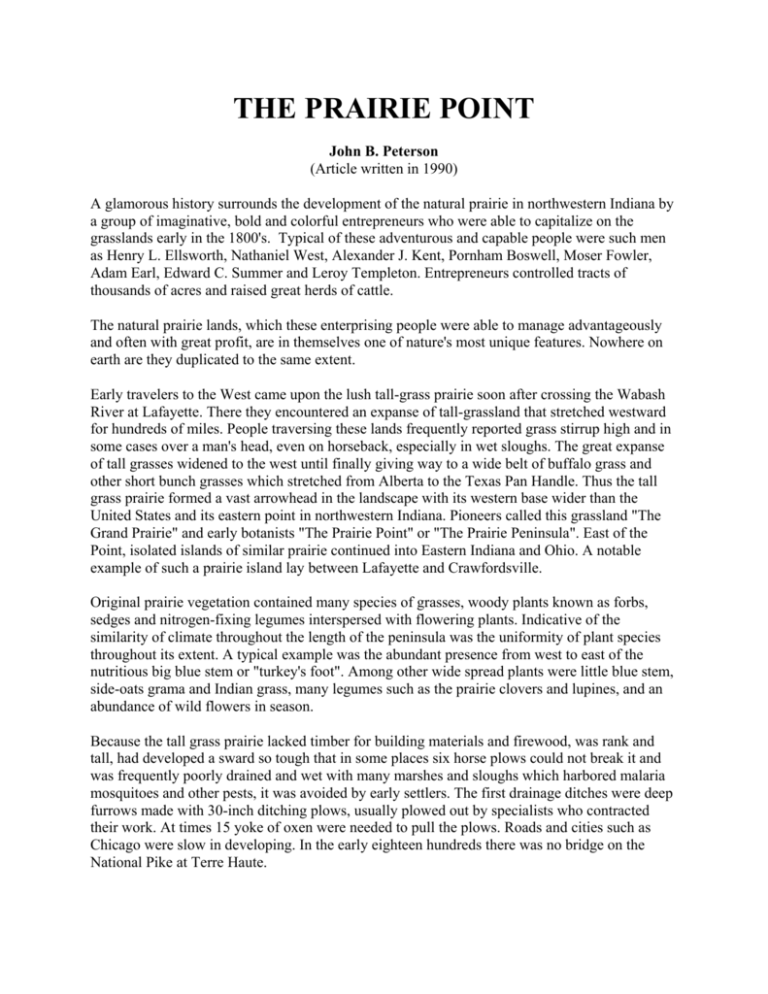
THE PRAIRIE POINT John B. Peterson (Article written in 1990) A glamorous history surrounds the development of the natural prairie in northwestern Indiana by a group of imaginative, bold and colorful entrepreneurs who were able to capitalize on the grasslands early in the 1800's. Typical of these adventurous and capable people were such men as Henry L. Ellsworth, Nathaniel West, Alexander J. Kent, Pornham Boswell, Moser Fowler, Adam Earl, Edward C. Summer and Leroy Templeton. Entrepreneurs controlled tracts of thousands of acres and raised great herds of cattle. The natural prairie lands, which these enterprising people were able to manage advantageously and often with great profit, are in themselves one of nature's most unique features. Nowhere on earth are they duplicated to the same extent. Early travelers to the West came upon the lush tall-grass prairie soon after crossing the Wabash River at Lafayette. There they encountered an expanse of tall-grassland that stretched westward for hundreds of miles. People traversing these lands frequently reported grass stirrup high and in some cases over a man's head, even on horseback, especially in wet sloughs. The great expanse of tall grasses widened to the west until finally giving way to a wide belt of buffalo grass and other short bunch grasses which stretched from Alberta to the Texas Pan Handle. Thus the tall grass prairie formed a vast arrowhead in the landscape with its western base wider than the United States and its eastern point in northwestern Indiana. Pioneers called this grassland "The Grand Prairie" and early botanists "The Prairie Point" or "The Prairie Peninsula". East of the Point, isolated islands of similar prairie continued into Eastern Indiana and Ohio. A notable example of such a prairie island lay between Lafayette and Crawfordsville. Original prairie vegetation contained many species of grasses, woody plants known as forbs, sedges and nitrogen-fixing legumes interspersed with flowering plants. Indicative of the similarity of climate throughout the length of the peninsula was the uniformity of plant species throughout its extent. A typical example was the abundant presence from west to east of the nutritious big blue stem or "turkey's foot". Among other wide spread plants were little blue stem, side-oats grama and Indian grass, many legumes such as the prairie clovers and lupines, and an abundance of wild flowers in season. Because the tall grass prairie lacked timber for building materials and firewood, was rank and tall, had developed a sward so tough that in some places six horse plows could not break it and was frequently poorly drained and wet with many marshes and sloughs which harbored malaria mosquitoes and other pests, it was avoided by early settlers. The first drainage ditches were deep furrows made with 30-inch ditching plows, usually plowed out by specialists who contracted their work. At times 15 yoke of oxen were needed to pull the plows. Roads and cities such as Chicago were slow in developing. In the early eighteen hundreds there was no bridge on the National Pike at Terre Haute. Small landowners lacked the capital and organization to tackle the tough and expensive problems of drainage, fencing, shelter and roads, necessary to a small-scale general farming economy. Not until the development of the steel plow by John Deere in 1837-40 did the small farmer have a manageable way of breaking the prairie. On the other hand the prairie with little if any modification favored large scale grazing, a natural extension of a well-established enterprise which had been moving westward since the days of the Revolution. As settlement had spread westward from the East Coast a vanguard of livestock grazing preceded a gradual shift to grain and general farming where grassland cattle could be driven for fattening. Thus marketing centers appeared which in time gave way one by one to newer terminals farther to the west. Successive market centers moved from New York and Baltimore to Philadelphia to Cincinnati to Indianapolis to Waterloo and Omaha. The driving of cattle from grasslands to the established grain areas, which had replaced the range, was a well-established and well-understood business as early as 1800. Consequently, it was only natural that men of means such as Templeton and his friends, "The Yale Crowd," would become interested in investing in cattle land in the Grand Prairie. In the early eighteen hundreds the time was right for such an enterprise. The demand for beef was high and growing as the population grew. The driving routes to market center were well established. By 1840 eastern capital was being heavily invested in Grand Prairie land and New York residents alone were reported to have purchased 30 large tracts. The many estates which were formed gave rise to a landed gentry who built luxurious homes and for the most part were interested more in improving the area and developing a lasting enterprise than in speculation. At first cattle were bought to run on the plentiful open range but as farmers began to homestead or buy smaller tracts in the area, the cattlemen found it necessary to buy the land to keep control of it. Land was plentiful and cheap, costing only a dollar to a few dollars an acre. Before many years of range enterprise the cattlemen began to grow corn for fattening cattle on the better drained prairie on their estates. An early example was Henry Ellsworth, who by 1849 had 1200 acres of corn in cultivation. The introduction of on-site corn production coupled with improvement in herds gave rise to a more independent, established agriculture. At first native cattle, usually of poor quality, called "barren cattle" were used but soon herds were improved by importation not only of better cattle but also of good breeding stock to upgrade the herds. Shorthorns were popular in the 1870's but were challenged in the 1880's by Herefords, promoted by such men as Adams Earl, A. D. Raub, Moses Fowler, and W. S. Van Natta. Typical of the early leaders of herd improvement was Fowler, who in 1868 was bringing Texas cattle into Indiana. These he soon replaced by developing his own herd of Herefords. In the eighteen eighties in partnership with William S. Van Natta, he imported Herefords from England as a foundation for their herds. In a short time he was able to advertise for sale "450 thoroughbred Hereford bulls, 50 thoroughbred Hereford cows and Heifers." Incidentally, Fowler in partnership with his brother-in-law, Adam Earl, owned 45,000 acres in Benton, Warren, and White counties. At one time he owned 20,000 acres in Benton County alone. As the land was improved by drainage and roads, corn and small grain became more profitable than pasture alone. As a result the life of farming in the Peninsula shifted to a more balanced system of pasture, grain, and livestock. The large estates became eroded through inheritance and sales into smaller tracts although some holdings continued as conglomerates of smaller sharecrop farms. The great area of tall grasses stretching westward was a mystery to the pioneers. Theories as to its origin included over-grazing by buffalo, periodic firing by Indians, the influence of earlier glaciating and the frequency of droughts and other climatic effects. Climatic influences proposed by early botanists, notably Edgar N. Transeau, are now considered the major causes of the protrusion of the grasslands into the eastern deciduous forests. Transeau's paper of 1935, now considered a classic, credited climatic effects as the main cause of the Prairie Peninsula. Newer data support this concept, also. Climatic analysis has revealed that the eastward projection of the western grasslands into humid Illinois and Indiana lies in an area of less precipitation than occurs in the surrounding Corn Belt, especially in the late summer time. Precipitation patterns characteristic of the Peninsula, which differ from most of the surrounding area are (1) typically low snowfall and rainfall in the winter; (2) a greater frequency of drought in summer, especially in the late summer; (3) fewer days of precipitation of overcast; and (4) more dry, hot windy spells in summer. Although the Peninsula, like most of the Corn Belt, is characterized by high rainfall in June and July it has usually less rainfall in August and September and more frequent late summer drought than in the surrounding land. Its climate in general bears similarities to that of the drier Northern Great Plains to the east of the Rockies. Actually the Peninsula is the result of an extension of the drier western climate as it is dragged eastward under the influence of the strong prevailing westerly air currents which flow over the area during the summer when the affect of climate on grass growth is critical. There is also good evidence that the jet stream tends to flow eastward within the Peninsula during the early growing season, a phenomenon that doubtless contributes to the eastward extension of the grasslands. In climatological terms the climate of the Peninsula, like that of the Great Plains, is said to have a distinct single late spring maximum in contrast to the double or triple warm season rainfall maxima in the surrounding Corn Belt. Thus, the climate of the Prairie Peninsula is more like that of the Great Plains than is the rest of the Corn Belt where late summer as well as spring rainfall is common. The more even distribution of warm season rainfall with less frequency of drought outside the Prairie Point in Indiana favors the growth of forests, such as the deciduous woods of Indiana. Lafayette lies just east of the eastern apex of the Prairie Point and in the main tract of the westerly flowing warm season air currents that bring the grassland climate eastward. On the west side of the Agronomy Farm only a few miles to the northwest of West Lafayette can be found dark-colored grassland soils, the Mollisols, and on the east side, light colored timber soils, the Alfisols. In a way, the soils of the Peninsula are a thumbprint of the unique arm of western climates, which has penetrated the deciduous forest land of west central Indiana. The prairie soil profiles in Indiana are similar to their counterparts to the west in Illinois and to some extent in Iowa. Where naturally well drained and not affected by erosion, soils definitely show the influence of past climate and vegetation. Prairie soils have deep, dark, friable, fertile surface soils high in organic matter whereas timber soils have a shallow, lighter-colored surface overlying a distinctly gray or grayish brown layer, low in minerals and nutrients. Prairie soils are inherently more fertile than timber soils but in the Corn Belt this advantage has been largely overcome by plentiful use of lime and fertilizer and good soil management, especially the building up of organic matter on the timber soils. As a result the contrast in productivity between the prairie soils and the deciduous forest soils is no longer very noticeable. However, the imprint on the earth resulting from the dynamics of the Prairie Point is still evident and serves as an indicator of a long history of different climate within than that outside the Point, a difference which, unless the climate of the last few thousand years is changing, may be expected to persist for many more years. Additional Reading: About the Author John Booth Peterson (1905-1994) Dr. Peterson has been described by his colleagues as the most widely known, best liked, and most influential agronomist in the world. Dr. Peterson received his B.S. degree from Oregon State University in 1928 and the Master of Science and Doctor of Philosophy degrees in 1929 and 1936, respectively. He continued teaching and research at Iowa State until 1948, when he was appointed head of the Department of Agronomy at Purdue University. He led the Purdue Agronomy Department until his retirement in 1971. His ability to analyze complex situations and to present his views in a clear, simple and persuasive manner, along with trust, made interdepartmental education and research ventures highly successful. Dr. Peterson developed international leadership. He took consulting assignments on agricultural research and institutional in developing countries with invitations from international agencies, foundations and foreign governments. Dr. Peterson developed programs with the Rockefeller and Ford Foundations for providing graduate education for promising young scientists from Mexico and many countries in South America, Central America, Africa and Asia. He played a significant role in the LARS earth science program as its deputy director from 1971 to 1981. He worked tirelessly, pioneering the use of remote sensing from space for soil surveys, among other innovations, and published the results of his basic studies of the spectral properties of soils. In 1982, Purdue University bestowed its most prestigious recognition on Dr. Peterson, an Honorary Doctor of Agriculture Degree for "his long and brilliant career of service to education, to agricultural science, and to all of the people of the Earth."



